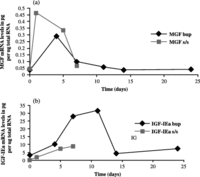Okay after continued debate between xtraflossy and I on Yahoo and digging through various sutudies we found mounting evidence as to why MGF is ineffective for people continually taking it! I am going to post a few excerpts from some studies then explain them. I apologize that there was one error in the manual stating that MGF proliferates, differentiates, fuses, AND activates these satellite stem cells. Although this information was correct in previous studies, newer studies have come out proving this wrong (yea im pissed too, done by the same damn doctor too! sheesh). I am updating the manual after this.
"MGF [4 and 6], is biologically active and has a distinct activity compared to that of mature IGF-I in that it can increase myoblasts proliferation but it totally inhibits the myotubes formation. Also the selective blocking of the IGF-I receptor provides evidence that MGF increases myoblast proliferation via a different signalling pathway."
"Two of MGF-positive C2C12 clones and two IGF-I Ea clones were used to study the effects of MGF and systemic IGF-I Ea on myoblast proliferation and differentiation. Fig. 1 demonstrates that positive MGF and IGF-I Ea C2C12 clones expressed transfected MGF or IGF-I Ea mRNA, whilst no exogenous MGF mRNA was detected in control C2C12 cells. When cells were induced to undergo myogenesis in the differentiation medium (DM), it was found that positive terminal differentiation was prevented in MGF-positive cells. Even these cells kept in DM for 14 days, remained as myoblasts (Fig. 2A). In contrast, those of the IGF-I Ea-positive clone formed myotubes (Fig. 2B). The normal C2C12 cells showed less cellular proliferation as well as forming myotubes ( Fig. 2C)."
As you can see in these two excerpts MGF actually proliferates the cells by bringing in additional stem cells/nuclei, but actually INHIBITS them from forming myotubes (differentiation). For those of you who don't know the exact definition of differentiation it is: Skeletal muscle differentiation involves myoblast alignment, elongation, and fusion into multinucleate myotubes, together with the induction of regulatory and structural muscle-specific genes.
This means that those of you who were doing MGF day in and day out were actually preventing your body from forming more myotubes. MGF is still an important piece of this puzzle because of its effects on muscle proliferation, but we need exogenous IGF afterwards to activate these things and differentiate the stem cells. This confims my hypothesis for my dosing scheme where I had (xtraflossy said he liked pre workout mgf so thats his idea) pre-post injected MGF as well as ONLY 1 more day of MGF injections which are done two different times the next day, making it ONLY 24 hours of MGF injections. Read the manual to see my exact dosing scheme.
I have attached a graph that is also in the manual showing how your body naturally responds to this stuff. Pay attention the the s/s numbers not the bup numbers since bup is something different. If you notice even your body stops making IGF in large quantities after 24 hours.
"MGF [4 and 6], is biologically active and has a distinct activity compared to that of mature IGF-I in that it can increase myoblasts proliferation but it totally inhibits the myotubes formation. Also the selective blocking of the IGF-I receptor provides evidence that MGF increases myoblast proliferation via a different signalling pathway."
"Two of MGF-positive C2C12 clones and two IGF-I Ea clones were used to study the effects of MGF and systemic IGF-I Ea on myoblast proliferation and differentiation. Fig. 1 demonstrates that positive MGF and IGF-I Ea C2C12 clones expressed transfected MGF or IGF-I Ea mRNA, whilst no exogenous MGF mRNA was detected in control C2C12 cells. When cells were induced to undergo myogenesis in the differentiation medium (DM), it was found that positive terminal differentiation was prevented in MGF-positive cells. Even these cells kept in DM for 14 days, remained as myoblasts (Fig. 2A). In contrast, those of the IGF-I Ea-positive clone formed myotubes (Fig. 2B). The normal C2C12 cells showed less cellular proliferation as well as forming myotubes ( Fig. 2C)."
As you can see in these two excerpts MGF actually proliferates the cells by bringing in additional stem cells/nuclei, but actually INHIBITS them from forming myotubes (differentiation). For those of you who don't know the exact definition of differentiation it is: Skeletal muscle differentiation involves myoblast alignment, elongation, and fusion into multinucleate myotubes, together with the induction of regulatory and structural muscle-specific genes.
This means that those of you who were doing MGF day in and day out were actually preventing your body from forming more myotubes. MGF is still an important piece of this puzzle because of its effects on muscle proliferation, but we need exogenous IGF afterwards to activate these things and differentiate the stem cells. This confims my hypothesis for my dosing scheme where I had (xtraflossy said he liked pre workout mgf so thats his idea) pre-post injected MGF as well as ONLY 1 more day of MGF injections which are done two different times the next day, making it ONLY 24 hours of MGF injections. Read the manual to see my exact dosing scheme.
I have attached a graph that is also in the manual showing how your body naturally responds to this stuff. Pay attention the the s/s numbers not the bup numbers since bup is something different. If you notice even your body stops making IGF in large quantities after 24 hours.
Attachments
-
23.2 KB Views: 290

